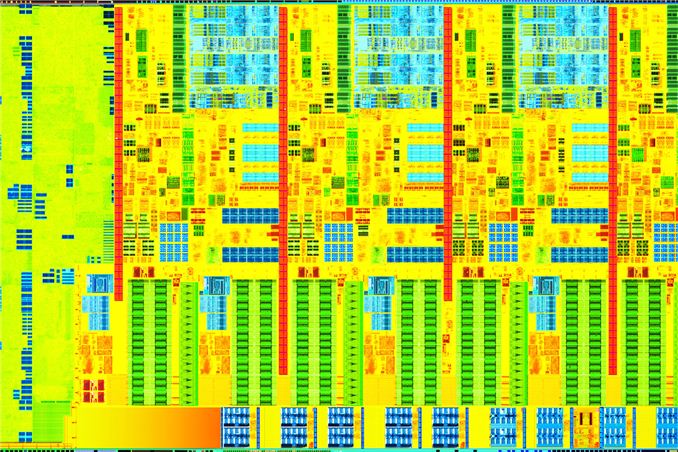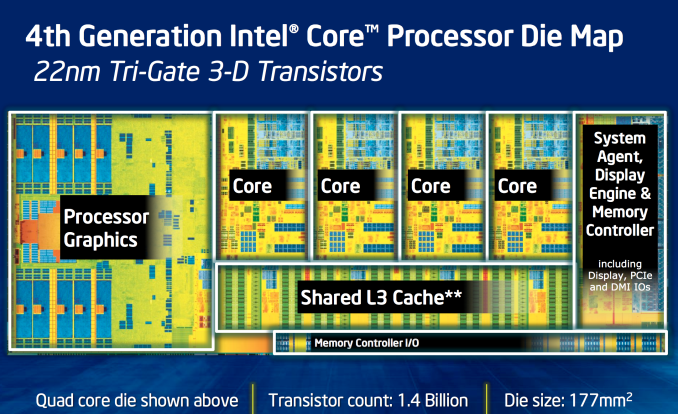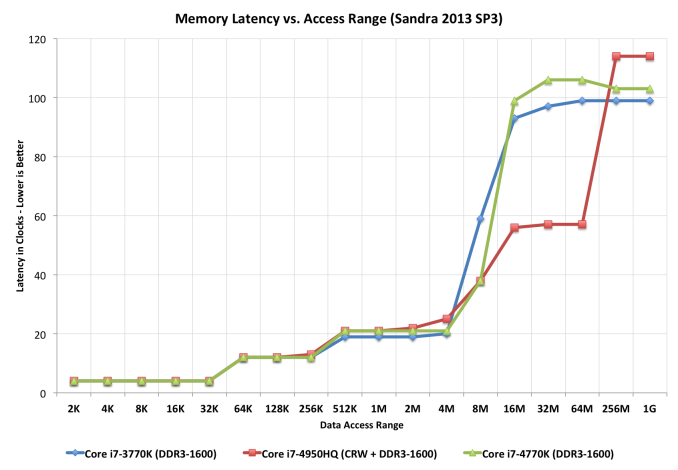The Haswell Review: Intel Core i7-4770K & i5-4670K Tested
by Anand Lal Shimpi on June 1, 2013 10:00 AM EST
This is a very volatile time for Intel. In an ARM-less vacuum, Intel’s Haswell architecture would likely be the most amazing thing to happen to the tech industry in years. In mobile Haswell is slated to bring about the single largest improvement in battery life in Intel history. In graphics, Haswell completely redefines the expectations for processor graphics. There are even some versions that come with an on-package 128MB L4 cache. And on the desktop, Haswell is the epitome of polish and evolution of the Core microprocessor architecture. Everything is better, faster and more efficient.
There’s very little to complain about with Haswell. Sure, the days of insane overclocks without touching voltage knobs are long gone. With any mobile-first, power optimized architecture, any excess frequency at default voltages is viewed as wasted power. So Haswell won’t overclock any better than Ivy Bridge, at least without exotic cooling.
You could also complain that, for a tock, the CPU performance gains aren’t large enough. Intel promised 5 - 15% gains over Ivy Bridge at the same frequencies, and most of my tests agree with that. It’s still forward progress, without substantial increases in power consumption, but it’s not revolutionary. We compare the rest of the industry to Intel’s excellent single threaded performance and generally come away disappointed. The downside to being on the top is that virtually all improvements appear incremental.
The fact of the matter is that the most exciting implementations of Haswell exist outside of the desktop parts. Big gains in battery life, power consumption and even a broadening of the types of form factors the Core family of processors will fit into all apply elsewhere. Over the coming weeks and months we’ll be seeing lots of that, but today, at least in this article, the focus is on the desktop.
Haswell CPU Architecture Recap
Haswell is Intel’s second 22nm microprocessor architecture, a tock in Intel’s nomenclature. I went through a deep dive on Haswell’s Architecture late last year after IDF, but I’ll offer a brief summary here.
At the front end of the pipeline, Haswell improved branch prediction. It’s the execution engine where Intel spent most of its time however. Intel significantly increased the sizes of buffers and datastructures within the CPU core. The out-of-order window grew, to feed an even more parallel set of execution resources.
Intel added two new execution ports (8 vs 6), a first since the introduction of the Core microarchitecture back in 2006.
On the ISA side, Intel added support for AVX2, which includes an FMA operation that considerably increases FP throughput of the machine. With a doubling of peak FP throughput, Intel doubled L1 cache bandwidth to feed the beast. Intel also added support for transactional memory instructions (TSX) on some Haswell SKUs.
The L3 cache is now back on its own power/frequency plane, although most of the time it seems to run in lockstep with the CPU cores. There appears to be a 2 - 3 cycle access penalty as a result of decoupling the L3 cache.


















210 Comments
View All Comments
eckre - Friday, June 14, 2013 - link
VERY disappointing CPU, if you disregard ALL of the fake synthetic benchmarks, and use only the real world ones, the gains over the 3770K are 0.03%, max 8.8% and average at about a 3% Improvement. 3%? Not worth it. Motherboard? Z87 was suppose to drop PCI but all the motherboards still have it and nothing outrageous. So basically lower power consumption, better on board video performance and no discernible improvement over the 3770K.i7Ahmed920D0 - Monday, June 24, 2013 - link
GOOD BYE 920 D0 Ill never forget you ! Your going to moms rig ! Helllllooooo 4670k with upto 40% better performance for 225 bucks !Yangorang - Thursday, June 27, 2013 - link
There are some rumors that the Haswell desktop processors run fairly hot - can you confirm this at all in your testing?calico-uk - Friday, July 12, 2013 - link
Face it, A consumers market, not a true imagine of technology evolution. Low power with high temps? Just doesn't ring true, unless the chip has been purposely ' Restricted ' with only one cause in mind sales and protection of future sales. In layman's terms Greedy bastards more concerned with markets and money and not the Desktop guy who's impressed with performance. Blame Mac, Windows 8. And your tiny fucking phone.James McGrath - Sunday, August 11, 2013 - link
This test is a little bias against the Core 2 duo I think. What they have done is essentially pitch the very top end on Intel's last 4 generations against a mid to low end core 2 duo. It would be more fair if that generation was represented by a qx9770 or even a Q9650.clyman - Wednesday, October 23, 2013 - link
I have been involved in computer hardware, software and programming since 1986. There has never been a more reliable processor than Intel, at any time. The current ones still have to be tested over time, but I would not buy one. If you put enough case fans with the inferior processors, they might last 2 or 3 years. With an Intel processor, even overclocked with no case fans, provided you used the intel chipset, nearly 100% of them kept running for 5 or more years. Without overclocking, I still don't know when they will die, since none have to my knowledge. I have built at least 100 computers and have only built a couple non intel ones. It was obvious right away how inferior they were to intel. Also, I love my i7 haswell on an asus z87-pro motherboard. There is no need to overclock, the processor and memory score 7.8 out of 7.9 on the windows scale and the onboard graphics scores a 6.8. Not bad ratings. Also, the CPU only uses 7 to 8 watts of power most of the time.numskulll - Tuesday, November 5, 2013 - link
I'm quite happy with my undervolted Athlon 620 and Radeon 4200 graphics. More computing power than I need 99% of the time, estimated tdp of about 55-60 watts (1% of use) and system idle of about 40w (80+% of use). And if I ever play games it takes a few seconds to bung in a suitable graphics card. I doubt it will go belly-up in the foreseeable future, but if it does it only cost £50 second-hand about 3 years ago and would be even less to buy now.duttasanjiv - Friday, November 14, 2014 - link
I am planning to get a new i5 4690 system for 1080p transcoding. I am not interested in GPU assisted transcoding. My focus is on QuickSync assisted transcoding. It is said that latest Quicksync is almost comparable to CPU based transcoding.It is annoying to see all sites compare only obsolate systems with a vague spec. (including AnandTech). Then, they omit any screenshots. Some are so weird thay put the video at youtube!! How can one compare the quality after youtube again transcoded it?
So far I am looking for a scientific, specific comparison on -
1) i5 4690 or atleast 4570 with CPU only & with QS
2) Screenshots in PNG
3) Specifying what settings were used? What QRF / what QCF? What speed presets - 'slow' or medium? What profile - high or main?. 'faster' or 'very fast' settings speed presets is worthless.
2) What is the source format - 1080i or 1080p? How long? What was the target size.
3) What QuickSync performance settings were used? I heard that haswell supports 7 performance vs quality settings. Also never found if QS supports any other parameters.
Merely mentioning FPS or time won't help.
I request you to pl. provide us with such an comprehensive comparison with will help many users like me, to settle all doubts for good. Thx so much in advance...
minitt - Sunday, December 7, 2014 - link
They dropped I5 750 and I7 920 from the gaming benchmark because both the processor will put up decent FPS which will take away most of the lime light from the haswell. A 4.0 ghz clocked i5 750 or i7 920 is still capable of keeping the modern GPUs running at 100% .I would be more than happy if someone can prove me wrong.Miller1331 - Tuesday, December 1, 2015 - link
I have the 4770k in my Desktop which is used primarily for high end music production and it eats up everything I have thrown at it thus far